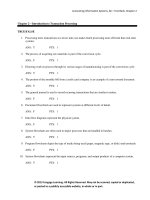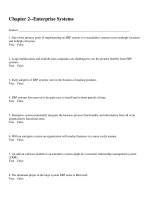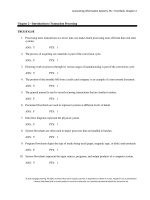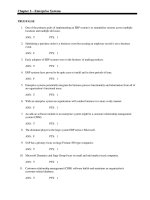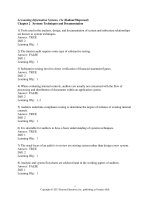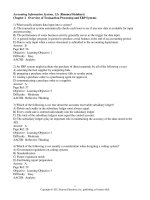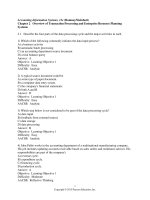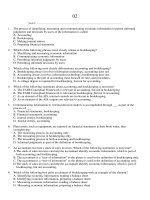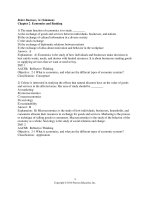Business driven information systems 3rd edition baltzan test bank
Bạn đang xem bản rút gọn của tài liệu. Xem và tải ngay bản đầy đủ của tài liệu tại đây (340.4 KB, 33 trang )
02
Student: ___________________________________________________________________________
1.
What is the primary reason for growth of Decision-Making Information Systems?
A. People need to analyze large amounts of information
B. People must make decisions quickly
C. People must apply sophisticated analysis techniques, such as modeling and forecasting to make good
decisions
D. People must protect the corporate asset of organizational information
E. All of the above
2.
Which of the following represents a top-down structure for decision-making in a typical organization?
A.
B.
C.
D.
Operational, Managerial, and Strategic
Managerial, Operational, and Strategic
Strategic, Operational, and Managerial
Strategic, Managerial, and Operational
3.
When a company is evaluating whether or not to produce a new product, it is typically a _____________
decision.
A. Operational
B. Managerial
C. Strategic
D. All of the above
4.
Which of the following is a common example of a TPS operational accounting system?
A. Payroll system
B. Expert system
C. CRM system
D. CAD system
5.
Where is the data stored that is often used to source the data and information contained in decision
support and executive information systems?
A. Transaction processing systems
B. AI systems
C. Expert systems
D. CRM system
6.
Which system is used for day-to-day business operational decisions?
A. Transactional Processing System (TPS)
B. Decision Support System (DSS)
C. Executive Information System (EIS)
D. None of the above
7.
The basic building block of data is provided by ______ system which is further used by other systems for
deriving analytical information.
A. Transactional Processing System (TPS)
B. Decision Support System (DSS)
C. Executive Information System (EIS)
D. None of the above
8.
The Executive Information System analyzes information to help executives in making _____ business
decisions.
A. Operational
B. Managerial
C. Strategic
D. None of the above
9.
Which of the following is an example of a neural network?
A. Banks use neural networks to find opportunities in financial markets.
B. Police use neural network software to fight crime.
C. Fraud detection widely uses neural networks.
D. All are examples of neural networks
10. Which feature can a neural network possess?
A. Learning and adjusting to new circumstances on their own.
B. Functioning without complete or well-structured information.
C. Coping with huge volumes of information with many dependent variables.
D. All are features of neural networks.
11. What does examining business processes helps an organization determine?
A. Bottlenecks
B. Create duplicate activities
C. Separate related activities
D. All of the above
12. _____________________________ result in a product or service that is received by an organization's
external customer.
A. Business facing processes
B. Customer facing processes
C. Product facing processes
D. Supplier facing processes
13. What is a graphic description of a process, showing the sequence of process tasks, which is developed for
a specific purpose and from a selected viewpoint?
A. Information process model
B. Leadership process model
C. Business process model
D. Graphic process model
14. What represents the current state of the operation that has been mapped, without any specific
improvements or changes to existing processes.
A. As-Is process models
B. To-Be process models
C. Past process models
D. Future process models
15. What is a business process?
A. The analysis and redesign of workflow within and between enterprises
B. A standardized set of activities that accomplish as specific task, such as processing a customer's order
CIntegrates all departments and functions throughout an organization into a single TI system so that
. employees can make decisions by viewing enterprisewide information on all business operations
D. None of the above
16. What is business process reengineering?
A. The analysis and redesign of workflow within and between enterprises
B. A standardized set of activities that accomplish as specific task, such as processing a customer's order
CIntegrates all departments and functions throughout an organization into a single TI system so that
. employees can make decisions by viewing enterprisewide information on all business operations
D. None of the above
17. What is the purpose of business process reengineering?
A. To make all business processes best-in-class
B. To make all employees best-in-class
C. To make all business partners best-in-class
D. All of the above
18. Which company used BPR to change its industry by implementing a mobile claims process?
A. Saab
B. Progressive Insurance
C. Trek
D. Charles Schwab
19. What encompasses all organizational information and its primary purpose is to support the performing of
managerial analysis tasks?
A. Transactional information
B. Analytical information
C. Timeliness
D. Quality
20. Which of the following is an example of transactional data?
A. Trend projection
B. Sales projection
C. Purchasing stock
D. All of the above
21. Which of the following is not a reason for the growth of decision-making information systems?
A. People need to analyze large amounts of information
B. People must make decisions quickly
C. People must apply sophisticated analysis techniques to make good decisions
D. People no longer have to worry about protecting the corporate asset of organizational information
22. Which of the following is a quantitative model typically used by a DSS?
A. Sensitivity analysis
B. What-if analysis
C. Goal-seeking analysis
D. All of the above
23. What is the study of the impact that changes in one (or more) parts of the model have on other parts of the
model?
A. Drill-down
B. Sensitivity analysis
C. Statistical analysis
D. Goal-seeking analysis
24. What finds the inputs necessary to achieve a goal, such as a desired level of output?
A. Drill-down
B. Sensitivity analysis
C. What-if analysis
D. Goal-seeking analysis
25. What is consolidation?
A. Involves the aggregation of information and features simple roll-ups to complex groupings of
interrelated information.
B. The ability to look at information from different perspectives
C. Enables users to get details, and details of details, of information
D. Finds the inputs necessary to achieve a goal such as a desired level of output
26. What is drill-down capability?
A. Involves the aggregation of information and features simple roll-ups to complex groupings of
interrelated information.
B. The ability to look at information from different perspectives
C. Enables users to get details, and details of details, of information
D. Finds the inputs necessary to achieve a goal such as a desired level of output
27. What is slice-and-dice capability?
A. Involves the aggregation of information and features simple roll-ups to complex groupings of
interrelated information.
B. The ability to look at information from different perspectives
C. Enables users to get details, and details of details, of information
D. Finds the inputs necessary to achieve a goal such as a desired level of output
28. Which of the following is not a measure of efficiency IS metric?
A. Throughput
B. Usability
C. Transaction speed
D. Response time
29. Which of the following is not a measure of effectiveness IS metric?
A. Usability
B. Customer satisfaction
C. Financial Return on Investment
D. System availability
30. What integrates information from multiple components and tailors the information to individual
preferences?
A. Drill-down
B. Sensitivity analysis
C. What-if analysis
D. Digital dashboard
31. What are various commercial applications of artificial intelligence?
A. Drill-down
B. Sensitivity analysis
C. Digital dashboard
D. Intelligent system
32. What is a category of AI that attempts to emulate the way the human brain works?
A. Intelligent system
B. Artificial intelligence
C. Expert systems
D. Neural network
33. Which of the following is the most commonly used form of AI in the business arena?
A. Intelligent system
B. Artificial intelligence
C. Expert system
D. Neural network
34. What is a special-purpose knowledge-based information system that accomplishes specific tasks on
behalf of its users?
A. Intelligent system
B. Artificial intelligence
C. Neural network
D. Intelligent agent
35. What is an artificial intelligence system that mimics the evolutionary, survival-of-the-fittest process to
generate increasingly better solutions to a problem?
A. Intelligent system
B. Artificial intelligence
C. Neural network
D. Genetic algorithm
36. Which artificial intelligence system enables telepresence, where users can be anywhere in the world and
the system allows them to work alone or together at a remote site?
A. Expert System
B. Intelligent Agent
C. Multi-Agent Systems and Agent-Based Modeling
D. Virtual Reality
37. Which of the following is the computer simulation software that allows a surgeon from a remote location
to perform a surgery operation by using the equipment that can be controlled remotely?
A. Expert System
B. Intelligent Agent
C. Multi-Agent Systems and Agent-Based Modeling
D. Virtual Reality
38. Which of the following represents the top-down (executives to analysts) organizational levels of
information technology systems?
A. TPS, DSS, EIS
B. DSS, TPS, EIS
C. EIS, DSS, TPS
D. None of the above, it varies from organization to organization
39. Which of the following is an incorrect enterprise view of information technology?
A. Processes are analytical for executives and transactional for analysts
B. Granularity is coarse for executives and fine for analysts
C. Processing is OLTP for executives and OLAP for analysts
D. None of the above
40. Which of the following is a type of transaction processing system?
A. Order processing
B. Sales
C. Manufacturing
D. Transportation
41. Which of the following is a type of decision support system?
A. Order processing
B. Inventory tracking
C. Manufacturing
D. All of the above
42. Which system differentiates an executive information system from a decision support system and a
transaction processing system?
A. Order processing system
B. Manufacturing system
C. Stock market information system
D. Transportation system
43. Which company has "The Wall of Shaygan", which is a digital dashboard that tracks 100-plus IT systems
on a single screen?
A. Burlington Northern and Santa Fe Railroad
B. BostonCoach
C. Verizon Communications
D. RivalWatch
44. Which company offers a strategic business information service using artificial intelligence that enables
organizations to track the product offering, pricing policies, and promotions of online competitors?
A. Burlington Northern and Santa Fe Railroad
B. BostonCoach
C. Verizon Communications
D. RivalWatch
45. Which of the following represents a mathematical method of handling imprecise or subjective
information?
A. Genetic algorithm
B. Fuzzy logic
C. Market basket analysis
D. Statistical analysis
46. What encompasses all of the information contained within a single business process or unit of work and
its primary purpose is to support the performing of daily operational tasks?
A. Transactional data
B. Analytical information
C. Timeliness
D. Quality
47. Which of the following is an example of transactional data?
A. Withdrawing cash from an ATM
B. Making an airline reservation
C. Purchasing stock
D. All of the above
48. Strategic decisions focus on short term objectives whereas Operational decisions focus on long term
objectives.
True False
49. Key performance indicators (KPIs) are the measures that are tied to business drivers.
True False
50. With information systems, efficiency IS metrics measure the performance of information system itself
whereas effectiveness IS metrics measure the impact that IS has on business processes.
True False
51. "Doing things right" addresses effectiveness whereas "Doing the right things" addresses efficiency.
True False
52. Benchmarks are baseline values the system seeks to attain.
True False
53. Companies frequently strive to improve their business processes by performing tasks faster, cheaper, and
better.
True False
54. As-Is process models show the results of applying change improvement opportunities to the current (AsIs) process model.
True False
55. Purchasing stocks is an example of analytical information.
True False
56. Transactional data is used when performing operational tasks and repetitive decisions such as analyzing
daily sales reports and production schedules to determine how much inventory to carry.
True False
57. A business process is the analysis and redesign of workflow within and between enterprises.
True False
58. Progressive Insurance used CRM to revamp its insurance claims process.
True False
59. A genetic algorithm is an artificial intelligence system that mimics the evolutionary, survival-of-the-fittest
process to generate increasingly better solutions to a problem.
True False
60. The ultimate goal of AI is the ability to build a system that can mimic human intelligence.
True False
61. Sensitivity analysis, what-if analysis, and market basket analysis are the three quantitative models
typically used by a DSS.
True False
62. Consolidation, drill-down, and slice-and-dice are the three most common capabilities offered in an
EIS.
True False
63. A shopping bot is one of the simplest examples of an intelligent agent.
True False
64. The most common example of a TPS is an operational accounting system such as a payroll system.
True False
65. Data stored in transaction processing systems is rarely used to source the data and information contained
in decision support and executive information systems.
True False
66. Mail-order companies use neural networks to determine which customers are and are not likely to order
from their catalogues.
True False
67. Functioning without complete or well-structured information is a feature of neural networks.
True False
68. Examining business processes helps an organization determine bottlenecks, eliminate duplicate activities,
combine related activities, and identify smooth-running processes.
True False
69. Business facing processes are invisible to the external customer but essential to the effective management
of the business and include goal setting, day-to-day planning, performance feedback, rewards, and
resource allocation
True False
70. ____________ are baseline values the system seeks to attain.
________________________________________
71. A(n) _________ agent is a special-purpose knowledge-based information system that accomplishes
specific tasks on behalf of its users.
________________________________________
72. A(n) _____________ bot is software that will search several retailer Web sites and provide a comparison
of each retailer's offerings including price and availability.
________________________________________
73. The most common example of a __________________ is an operational accounting system such as a
payroll system or an order-entry system.
________________________________________
74. __________________ stored in transaction processing systems are often used to source the data and
information contained in decision support and executive information systems.
________________________________________
75. Police use _______________ network software to fight crime
________________________________________
76. Coping with huge volumes of information with many dependent variables is a feature of
______________________.
________________________________________
77. _________________ is a computer-simulated environment that can be a simulated world or an imaginary
world.
________________________________________
78. Examining _____________________________ helps an organization determine bottlenecks, eliminate
duplicate activities, combine related activities, and identify smooth-running processes.
________________________________________
79. ____________________________ are invisible to the external customer but essential to the effective
management of the business and include goal setting, day-to-day planning, performance feedback,
rewards, and resource allocation
________________________________________
80. A ________________________ is a graphic description of a process, showing the sequence of process
tasks, which is developed for a specific purpose and from a selected viewpoint.
________________________________________
81. _____________________________ represent the current state of the operation that has been mapped,
without any specific improvements or changes to existing processes.
________________________________________
82. ____________ information encompasses all of the information contained within a single business process
or unit of work and its primary purpose is to support the performing of daily operational tasks.
________________________________________
83. ____________ information encompasses all organizational information and its primary purpose is to
support the performing of managerial analysis tasks.
________________________________________
84. Organizations use _______________ information to make repetitive decisions.
________________________________________
85. Organizations use _________ information to make ad hoc decisions.
________________________________________
86. Business process reengineering is the analysis and _________ of workflow within and between
enterprises.
________________________________________
87. A decision support system models __________ to support managers and business professionals during
the decision-making process.
________________________________________
88. ___________ analysis occurs when users change the value of one variable repeatedly and observe the
resulting changes in other variables.
________________________________________
89. What-if analysis checks the impact of a __________ in an assumption on the proposed solution.
________________________________________
90. _________ seeking analysis could answer the question "How many customers are required to purchase
our new product line to increase gross profits to $5 million?"
________________________________________
91. __________ logic is a mathematical method of handling imprecise or subjective information.
________________________________________
92. _____________ systems are various commercial applications of artificial intelligence.
________________________________________
93. Artificial intelligence simulates ______________ intelligence such as the ability to reason and learn.
________________________________________
94. ______________ systems are computerized advisory programs that imitate the reasoning processes of
experts in solving difficult problems.
________________________________________
95. Distinguish between transactional data and analytical data.
96. What are KPIs, and how they are used?
97. Distinguish between OLTP and OLAP with respect to the types of decisions made.
98. List and define the five most common categories of AI.
99. Define the ultimate goal of AI and describe a few current examples of how AI is being used throughout
industries.
100.Discuss why organizations would undertake Business Process Reengineering?
101.Discuss why business processes should drive information systems choices?
102.Identify how an organization can use business process reengineering to improve its business.
103.List and define the four primary reasons for the growth of decision-making information systems.
104.Describe the three capabilities commonly offered by an EIS.
02 Key
1.
(p. 29)
What is the primary reason for growth of Decision-Making Information Systems?
A. People need to analyze large amounts of information
B. People must make decisions quickly
C. People must apply sophisticated analysis techniques, such as modeling and forecasting to make
good decisions
D. People must protect the corporate asset of organizational information
E. All of the above
The primary reason for growth in information systems is the availability of a large amount of data
which can be analyzed for understanding the business trend, and to arrive at better business decisions
quickly. It is also important for organizations to protect their information assets. The current decisionmaking information systems offer a better data security and protection mechanisms.
Chapter - Chapter 02 #1
Gradable: automatic
Learning Outcome: 2.1
Level: Easy
2.
Which of the following represents a top-down structure for decision-making in a typical organization?
(p. 30)
A.
B.
C.
D.
Operational, Managerial, and Strategic
Managerial, Operational, and Strategic
Strategic, Operational, and Managerial
Strategic, Managerial, and Operational
A typical organization is structured to perform the strategic decisions by top management, managerial
decisions by middle management, and operational decisions by direct managers or employees.
Chapter - Chapter 02 #2
Gradable: automatic
Learning Outcome: 2.2
Level: Easy
3.
(p. 30)
When a company is evaluating whether or not to produce a new product, it is typically a
_____________ decision.
A. Operational
B. Managerial
C. Strategic
D. All of the above
A company revamps its products in a medium term, which involves discontinuing some of the
products and introducing new products.
Chapter - Chapter 02 #3
Gradable: automatic
Learning Outcome: 2.2
Level: Easy
4.
(p. 35)
Which of the following is a common example of a TPS operational accounting system?
A. Payroll system
B. Expert system
C. CRM system
D. CAD system
The most common example of a TPS is an operational accounting system such as a payroll system or
an order-entry system.
Chapter - Chapter 02 #4
Gradable: automatic
Learning Outcome: 2.2
Level: Medium
5.
(p. 35)
Where is the data stored that is often used to source the data and information contained in decision
support and executive information systems?
A. Transaction processing systems
B. AI systems
C. Expert systems
D. CRM system
The reason for this is that data stored in transaction processing systems are often used to source the
data and information contained in decision support and executive information systems.
Chapter - Chapter 02 #5
Gradable: automatic
Learning Outcome: 2.2
Level: Medium
6.
(p. 39)
Which system is used for day-to-day business operational decisions?
A. Transactional Processing System (TPS)
B. Decision Support System (DSS)
C. Executive Information System (EIS)
D. None of the above
The operational decisions are of short term and often represent day-to-day transactions.
Chapter - Chapter 02 #6
Gradable: automatic
Learning Outcome: 2.2
Level: Medium
7.
(p. 39)
The basic building block of data is provided by ______ system which is further used by other systems
for deriving analytical information.
A. Transactional Processing System (TPS)
B. Decision Support System (DSS)
C. Executive Information System (EIS)
D. None of the above
TPS often used to source the data as a basic building block of data for further analysis.
Chapter - Chapter 02 #7
Gradable: automatic
Learning Outcome: 2.2
Level: Medium
8.
(p. 39)
The Executive Information System analyzes information to help executives in making _____ business
decisions.
A. Operational
B. Managerial
C. Strategic
D. None of the above
The Executive Information System analyzes information to help executives in making strategic
business decisions.
Chapter - Chapter 02 #8
Gradable: automatic
Learning Outcome: 2.2
Level: Medium
9.
(p. 41)
Which of the following is an example of a neural network?
A. Banks use neural networks to find opportunities in financial markets.
B. Police use neural network software to fight crime.
C. Fraud detection widely uses neural networks.
D. All are examples of neural networks
All are examples of neural networks
Chapter - Chapter 02 #9
Gradable: automatic
Learning Outcome: 2.3
Level: Medium
10.
(p. 40)
Which feature can a neural network possess?
A. Learning and adjusting to new circumstances on their own.
B. Functioning without complete or well-structured information.
C. Coping with huge volumes of information with many dependent variables.
D. All are features of neural networks.
Neural networks can possess many features, including: Learning and adjusting to new circumstances
on their own, Lending themselves to massive parallel processing, Functioning without complete
or well-structured information, Coping with huge volumes of information with many dependent
variables, Analysing non-linear relationships (they have been called fancy regression analysis
systems).
Chapter - Chapter 02 #10
Gradable: automatic
Learning Outcome: 2.3
Level: Medium
11.
(p. 44)
What does examining business processes helps an organization determine?
A. Bottlenecks
B. Create duplicate activities
C. Separate related activities
D. All of the above
Examining business processes helps an organization determine bottlenecks, eliminate duplicate
activities, combine related activities, and identify smooth-running processes.
Chapter - Chapter 02 #11
Gradable: automatic
Learning Outcome: 2.5
Level: Medium
12.
(p. 45)
_____________________________ result in a product or service that is received by an organization's
external customer.
A. Business facing processes
B. Customer facing processes
C. Product facing processes
D. Supplier facing processes
Customer facing processes
Chapter - Chapter 02 #12
Gradable: automatic
Learning Outcome: 2.5
Level: Medium
13.
(p. 48)
What is a graphic description of a process, showing the sequence of process tasks, which is developed
for a specific purpose and from a selected viewpoint?
A. Information process model
B. Leadership process model
C. Business process model
D. Graphic process model
Definition of a business process model
Chapter - Chapter 02 #13
Gradable: automatic
Learning Outcome: 2.5
Level: Medium
14.
(p. 49)
What represents the current state of the operation that has been mapped, without any specific
improvements or changes to existing processes.
A. As-Is process models
B. To-Be process models
C. Past process models
D. Future process models
Definitions of As-Is process models
Chapter - Chapter 02 #14
Gradable: automatic
Learning Outcome: 2.5
Level: Medium
15.
(p. 44)
What is a business process?
A. The analysis and redesign of workflow within and between enterprises
B. A standardized set of activities that accomplish as specific task, such as processing a customer's
order
CIntegrates all departments and functions throughout an organization into a single TI system so that
. employees can make decisions by viewing enterprisewide information on all business operations
D. None of the above
This is the definition of business process.
Chapter - Chapter 02 #15
Gradable: automatic
Learning Outcome: 2.5
Level: Easy
16.
(p. 46)
What is business process reengineering?
A. The analysis and redesign of workflow within and between enterprises
B. A standardized set of activities that accomplish as specific task, such as processing a customer's
order
CIntegrates all departments and functions throughout an organization into a single TI system so that
. employees can make decisions by viewing enterprisewide information on all business operations
D. None of the above
This is the definition of BPR.
Chapter - Chapter 02 #16
Gradable: automatic
Learning Outcome: 2.5
Level: Easy
17.
(p. 46)
What is the purpose of business process reengineering?
A. To make all business processes best-in-class
B. To make all employees best-in-class
C. To make all business partners best-in-class
D. All of the above
The purpose of BPR is to make all business processes best-in-class.
Chapter - Chapter 02 #17
Gradable: automatic
Learning Outcome: 2.5
Level: Easy
18.
(p. 47)
Which company used BPR to change its industry by implementing a mobile claims process?
A. Saab
B. Progressive Insurance
C. Trek
D. Charles Schwab
Progressive Insurance used BPR to change its industry by implementing a mobile claims process.
Chapter - Chapter 02 #18
Gradable: automatic
Learning Outcome: 2.5
Level: Medium
19.
(p. 31)
What encompasses all organizational information and its primary purpose is to support the performing
of managerial analysis tasks?
A. Transactional information
B. Analytical information
C. Timeliness
D. Quality
This is the definition of analytical information.
Chapter - Chapter 02 #19
Gradable: automatic
Learning Outcome: 2.1
Level: Easy
20.
(p. 35)
Which of the following is an example of transactional data?
A. Trend projection
B. Sales projection
C. Purchasing stock
D. All of the above
Purchasing stock is an example of transactional data
Chapter - Chapter 02 #20
Gradable: automatic
Learning Outcome: 2.1
Level: Medium
21.
(p. 29)
Which of the following is not a reason for the growth of decision-making information systems?
A. People need to analyze large amounts of information
B. People must make decisions quickly
C. People must apply sophisticated analysis techniques to make good decisions
D. People no longer have to worry about protecting the corporate asset of organizational information
People must protect the corporate asset of organizational information; it is one of their competitive
advantages.
Chapter - Chapter 02 #21
Gradable: automatic
Learning Outcome: 2.1
Level: Easy
22.
(p. 35-36)
Which of the following is a quantitative model typically used by a DSS?
A. Sensitivity analysis
B. What-if analysis
C. Goal-seeking analysis
D. All of the above
A DSS can perform all of the above.
Chapter - Chapter 02 #22
Gradable: automatic
Learning Outcome: 2.2
Level: Easy
23.
(p. 35)
What is the study of the impact that changes in one (or more) parts of the model have on other parts of
the model?
A. Drill-down
B. Sensitivity analysis
C. Statistical analysis
D. Goal-seeking analysis
Feedback: This is the definition of sensitivity analysis.
Chapter - Chapter 02 #23
Gradable: automatic
Learning Outcome: 2.2
Level: Easy
24.
(p. 36)
What finds the inputs necessary to achieve a goal, such as a desired level of output?
A. Drill-down
B. Sensitivity analysis
C. What-if analysis
D. Goal-seeking analysis
This is the definition of goal-seeking analysis.
Chapter - Chapter 02 #24
Gradable: automatic
Learning Outcome: 2.2
Level: Easy
25.
(p. 32)
What is consolidation?
A. Involves the aggregation of information and features simple roll-ups to complex groupings of
interrelated information.
B. The ability to look at information from different perspectives
C. Enables users to get details, and details of details, of information
D. Finds the inputs necessary to achieve a goal such as a desired level of output
This is the definition of consolidation.
Chapter - Chapter 02 #25
Gradable: automatic
Learning Outcome: 2.1
Level: Easy
26.
(p. 32)
What is drill-down capability?
A. Involves the aggregation of information and features simple roll-ups to complex groupings of
interrelated information.
B. The ability to look at information from different perspectives
C. Enables users to get details, and details of details, of information
D. Finds the inputs necessary to achieve a goal such as a desired level of output
This is the definition of drill-down.
Chapter - Chapter 02 #26
Gradable: automatic
Learning Outcome: 2.1
Level: Easy
27.
(p. 32)
What is slice-and-dice capability?
A. Involves the aggregation of information and features simple roll-ups to complex groupings of
interrelated information.
B. The ability to look at information from different perspectives
C. Enables users to get details, and details of details, of information
D. Finds the inputs necessary to achieve a goal such as a desired level of output
This is the definition of slice-and-dice.
Chapter - Chapter 02 #27
Gradable: automatic
Learning Outcome: 2.1
Level: Easy
28.
(p. 34)
Which of the following is not a measure of efficiency IS metric?
A. Throughput
B. Usability
C. Transaction speed
D. Response time
Usability is the ease of performing transactions and/or finding information, which is an IS metric
for effectiveness. A popular usability metric on the Internet is the number of clicks required to find
desired information.
Chapter - Chapter 02 #28
Gradable: automatic
Learning Outcome: 2.1
Level: Hard
29.
(p. 34)
Which of the following is not a measure of effectiveness IS metric?
A. Usability
B. Customer satisfaction
C. Financial Return on Investment
D. System availability
System availability is the number of hours an IS system is available to users. It is an IS metric for
efficiency.
Chapter - Chapter 02 #29
Gradable: automatic
Learning Outcome: 2.1
Level: Hard
30.
(p. 37)
What integrates information from multiple components and tailors the information to individual
preferences?
A. Drill-down
B. Sensitivity analysis
C. What-if analysis
D. Digital dashboard
This is the definition of digital dashboards.
Chapter - Chapter 02 #30
Gradable: automatic
Learning Outcome: 2.2
Level: Easy
31.
(p. 40)
What are various commercial applications of artificial intelligence?
A. Drill-down
B. Sensitivity analysis
C. Digital dashboard
D. Intelligent system
This is the definition of intelligent systems.
Chapter - Chapter 02 #31
Gradable: automatic
Learning Outcome: 2.3
Level: Easy
32.
(p. 40)
What is a category of AI that attempts to emulate the way the human brain works?
A. Intelligent system
B. Artificial intelligence
C. Expert systems
D. Neural network
This is the definition of neural network.
Chapter - Chapter 02 #32
Gradable: automatic
Learning Outcome: 2.3
Level: Easy
33.
(p. 40)
Which of the following is the most commonly used form of AI in the business arena?
A. Intelligent system
B. Artificial intelligence
C. Expert system
D. Neural network
Expert systems are the most common.
Chapter - Chapter 02 #33
Gradable: automatic
Learning Outcome: 2.3
Level: Medium
34.
(p. 42)
What is a special-purpose knowledge-based information system that accomplishes specific tasks on
behalf of its users?
A. Intelligent system
B. Artificial intelligence
C. Neural network
D. Intelligent agent
This is the definition of intelligent agent.
Chapter - Chapter 02 #34
Gradable: automatic
Learning Outcome: 2.3
Level: Medium
35.
(p. 41)
What is an artificial intelligence system that mimics the evolutionary, survival-of-the-fittest process to
generate increasingly better solutions to a problem?
A. Intelligent system
B. Artificial intelligence
C. Neural network
D. Genetic algorithm
This is the definition of genetic algorithm.
Chapter - Chapter 02 #35
Gradable: automatic
Learning Outcome: 2.3
Level: Easy
36.
(p. 43)
Which artificial intelligence system enables telepresence, where users can be anywhere in the world
and the system allows them to work alone or together at a remote site?
A. Expert System
B. Intelligent Agent
C. Multi-Agent Systems and Agent-Based Modeling
D. Virtual Reality
This is an application of virtual reality system.
Chapter - Chapter 02 #36
Gradable: automatic
Learning Outcome: 2.3
Level: Medium
37.
(p. 43)
Which of the following is the computer simulation software that allows a surgeon from a remote
location to perform a surgery operation by using the equipment that can be controlled remotely?
A. Expert System
B. Intelligent Agent
C. Multi-Agent Systems and Agent-Based Modeling
D. Virtual Reality
This is an application of virtual reality system.
Chapter - Chapter 02 #37
Gradable: automatic
Learning Outcome: 2.3
Level: Medium
38.
(p. 31)
Which of the following represents the top-down (executives to analysts) organizational levels of
information technology systems?
A. TPS, DSS, EIS
B. DSS, TPS, EIS
C. EIS, DSS, TPS
D. None of the above, it varies from organization to organization
Executive information systems, decision support systems, and transaction processing systems is the
top-down organizational levels of information technology systems.
Chapter - Chapter 02 #38
Gradable: automatic
Learning Outcome: 2.2
Level: Easy
39.
(p. 32)
Which of the following is an incorrect enterprise view of information technology?
A. Processes are analytical for executives and transactional for analysts
B. Granularity is coarse for executives and fine for analysts
C. Processing is OLTP for executives and OLAP for analysts
D. None of the above
Processing is OLAP for executives and OLTP for analysts.
Chapter - Chapter 02 #39
Gradable: automatic
Learning Outcome: 2.1
Level: Medium
40.
(p. 35)
Which of the following is a type of transaction processing system?
A. Order processing
B. Sales
C. Manufacturing
D. Transportation
Order processing is a transaction processing system.
Chapter - Chapter 02 #40
Gradable: automatic
Learning Outcome: 2.1
Level: Medium
41.
(p. 35)
Which of the following is a type of decision support system?
A. Order processing
B. Inventory tracking
C. Manufacturing
D. All of the above
Manufacturing is a type of decision support system.
Chapter - Chapter 02 #41
Gradable: automatic
Learning Outcome: 2.2
Level: Medium
42.
(p. 37)
Which system differentiates an executive information system from a decision support system and a
transaction processing system?
A. Order processing system
B. Manufacturing system
C. Stock market information system
D. Transportation system
A stock market information system is only found in an executive information system since it is an
external source of information, the rest are internal sources of information.
Chapter - Chapter 02 #42
Gradable: automatic
Learning Outcome: 2.2
Level: Medium
43.
(p. 38)
Which company has "The Wall of Shaygan", which is a digital dashboard that tracks 100-plus IT
systems on a single screen?
A. Burlington Northern and Santa Fe Railroad
B. BostonCoach
C. Verizon Communications
D. RivalWatch
Verizon Communications has The Wall of Shaygan.
Chapter - Chapter 02 #43
Gradable: automatic
Learning Outcome: 2.2
Level: Hard
44.
(p. 40)
Which company offers a strategic business information service using artificial intelligence that
enables organizations to track the product offering, pricing policies, and promotions of online
competitors?
A. Burlington Northern and Santa Fe Railroad
B. BostonCoach
C. Verizon Communications
D. RivalWatch
RivalWatch offers the above service.
Chapter - Chapter 02 #44
Gradable: automatic
Learning Outcome: 2.3
Level: Easy
45.
(p. 41)
Which of the following represents a mathematical method of handling imprecise or subjective
information?
A. Genetic algorithm
B. Fuzzy logic
C. Market basket analysis
D. Statistical analysis
This is the definition of fuzzy logic.
Chapter - Chapter 02 #45
Gradable: automatic
Learning Outcome: 2.3
Level: Easy
46.
(p. 31)
What encompasses all of the information contained within a single business process or unit of work
and its primary purpose is to support the performing of daily operational tasks?
A. Transactional data
B. Analytical information
C. Timeliness
D. Quality
This is the definition of transactional data.
Chapter - Chapter 02 #46
Gradable: automatic
Learning Outcome: 2.1
Level: Easy
47.
(p. 31)
Which of the following is an example of transactional data?
A. Withdrawing cash from an ATM
B. Making an airline reservation
C. Purchasing stock
D. All of the above
All of the above are examples of transactional data
Chapter - Chapter 02 #47
Gradable: automatic
Learning Outcome: 2.1
Level: Medium
48.
(p. 30)
Strategic decisions focus on short term objectives whereas Operational decisions focus on long term
objectives.
FALSE
Strategic decisions focus on long term objectives which are typically of three to five years,
Operational decisions focus on short term objectives which are typically weekly or monthly.
Chapter - Chapter 02 #48
Gradable: automatic
Learning Outcome: 2.2
Level: Medium
49.
(p. 32)
Key performance indicators (KPIs) are the measures that are tied to business drivers.
TRUE
It is the definition of KPIs.
Chapter - Chapter 02 #49
Gradable: automatic
Learning Outcome: 2.1
Level: Medium
50.
(p. 32)
With information systems, efficiency IS metrics measure the performance of information system itself
whereas effectiveness IS metrics measure the impact that IS has on business processes.
TRUE
These are definitions.
Chapter - Chapter 02 #50
Gradable: automatic
Learning Outcome: 2.1
Level: Medium
51.
(p. 32)
"Doing things right" addresses effectiveness whereas "Doing the right things" addresses
efficiency.
FALSE
"Doing things right" addresses efficiency whereas "Doing the right things" addresses effectiveness.
Chapter - Chapter 02 #51
Gradable: automatic
Learning Outcome: 2.1
Level: Medium
52.
(p. 32)
Benchmarks are baseline values the system seeks to attain.
TRUE
It is the definition.
Chapter - Chapter 02 #52
Gradable: automatic
Learning Outcome: 2.1
Level: Medium
53.
(p. 47)
Companies frequently strive to improve their business processes by performing tasks faster, cheaper,
and better.
TRUE
Companies frequently strive to improve their business processes by performing tasks faster, cheaper,
and better.
Chapter - Chapter 02 #53
Gradable: automatic
Learning Outcome: 2.5
Level: Medium
54.
(p. 49)
As-Is process models show the results of applying change improvement opportunities to the current
(As-Is) process model.
FALSE
To-Be process models show the results of applying change improvement opportunities to the current
(As-Is) process model.
Chapter - Chapter 02 #54
Gradable: automatic
Learning Outcome: 2.5
Level: Medium
55.
(p. 31)
Purchasing stocks is an example of analytical information.
FALSE
Purchasing stocks is an example of transactional information.
Chapter - Chapter 02 #55
Gradable: automatic
Learning Outcome: 2.1
Level: Easy
56.
(p. 31)
Transactional data is used when performing operational tasks and repetitive decisions such as
analyzing daily sales reports and production schedules to determine how much inventory to carry.
TRUE
Transactional data is used to perform operational tasks.
Chapter - Chapter 02 #56
Gradable: automatic
Learning Outcome: 2.1
Level: Easy
57.
(p. 44)
A business process is the analysis and redesign of workflow within and between enterprises.
FALSE
This is the definition for business process reengineering, not business process.
Chapter - Chapter 02 #57
Gradable: automatic
Learning Outcome: 2.5
Level: Easy
58.
(p. 47)
Progressive Insurance used CRM to revamp its insurance claims process.
FALSE
Progressive Insurance used BPR to revamp its insurance claims process.
Chapter - Chapter 02 #58
Gradable: automatic
Learning Outcome: 2.5
Level: Easy
59.
(p. 41)
A genetic algorithm is an artificial intelligence system that mimics the evolutionary, survival-of-thefittest process to generate increasingly better solutions to a problem.
TRUE
This is the definition of genetic algorithm.
Chapter - Chapter 02 #59
Gradable: automatic
Learning Outcome: 2.3
Level: Easy
60.
(p. 40)
The ultimate goal of AI is the ability to build a system that can mimic human intelligence.
TRUE
This is the ultimate goal of AI.
Chapter - Chapter 02 #60
Gradable: automatic
Learning Outcome: 2.3
Level: Easy
61.
(p. 35)
Sensitivity analysis, what-if analysis, and market basket analysis are the three quantitative models
typically used by a DSS.
FALSE
Sensitivity analysis, what-if analysis, and goal-seeking analysis are the three quantitative models
typically used by a DSS.
Chapter - Chapter 02 #61
Gradable: automatic
Learning Outcome: 2.2
Level: Easy
62.
(p. 35)
Consolidation, drill-down, and slice-and-dice are the three most common capabilities offered in an
EIS.
TRUE
These are the three most common capabilities offered in an EIS.
Chapter - Chapter 02 #62
Gradable: automatic
Learning Outcome: 2.1
Level: Easy
63.
(p. 42)
A shopping bot is one of the simplest examples of an intelligent agent.
TRUE
A shopping bot is a simple example of an intelligent agent.
Chapter - Chapter 02 #63
Gradable: automatic
Learning Outcome: 2.3
Level: Easy

